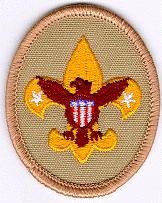 First Aid
First Aid
First Aid is the first help that is given
to the victim of an injury. For any injury that you think is serious seek
help from an adult. Always make the victim comfortable and stay with him until
help arrives.
Treating for shock. Make sure all the airways are open. Have the injured
person lie down. Raise his feet 10" to 12". Keep him warm with blankets
both under and over him. Seek medical help.
Treating cuts and scratches. Wash wounds with soap and water. Apply antiseptic
to help prevent infection. Apply adhesive bandage. For larger cuts, apply
direct pressure using a clean cloth. If more than one cloth is needed, apply
the second cloth directly over the first. Once the bleeding is under control,
bandage with a sterile bandage. When dealing with a serious wound, treat for
shock and consult a physician as soon as possible.
Treating blisters on the hand or foot. A hot spot on the skin due to
friction is a warning that a blister is forming. Use a doughnut bandage made
of moleskin to help ease the friction. If it is necessary to continue the
activity that is causing the blister, drain the fluid. First wash the area
with soap and water. Sterilize a needle with a flame. Pierce the blister with
the pin nearest the lowest edge and push fluid out. For example if the blister
was on the back of the heel, slide the needle up from the bottom of the foot
so the fluid drains down. Apply moleskin and bandage.
Treating minor burns. Get the victim away from the source of the burn.
For a minor (first degree) burn the cause is usually due to sunburn, steam,
or touching something hot. There is no sign of blisters (second degree), or
charred flesh (third degree). Cool the skin by applying a cool wet compress
or rinse with cold water. Do not apply oil based creams.
Treating stings and bites from bees and ticks. For bee stings, scrape
away the singer with a knife blade and apply an ice pack. For ticks, do not
pull on the tick if it is embedded in the skin. Apply Vaseline or hold a warm
match (after the flame is out) near the tick. This will loosen its hold. Apply
antiseptic, and cover with a bandage. Remove any rings and jewelry that could
cause a problem if swelling occurs.
Treating poisonous snake bites. Wash the bite with soap and water,
apply antiseptic and bandage. If you believe the snake is poisonous, get the
victim to medical care as soon as possible. Remove any rings and jewelry that
could cause a problem if swelling occurs. Keep the victim comfortable and
treat for shock. Elevate the part of the body that was bitten above the heart.
Stay with the victim until help arrives. Do not apply ice to the bite.
Treating nosebleeds. Have the victim sit up and lean forward to prevent
blood from draining down the throat. Pinch the nostrils together. Apply a
cold wet cloth to the face and nose.
Treating frostbite and sunburn. Signs of frostbite are ears, nose,
fingers, or feet that feel painful and then numb while out in the cold. Skin
may have grayish-white patches. Get the victim out of the cold, warm him up
and keep him warm. This can be done by holding the affected area under your
armpit, or against your warm skin. You may also hold the affected area under
warm (not hot) water, or wrap the victim in a blanket. Avoid rubbing the frostbitten
skin. For sunburn prevention is easy. Apply sunscreen often (minimum SPF-15).
Wear a hat and long sleeves if you will be in direct sun for an extended period.
If you do get sunburn, keep your skin cool and comfortable. Wear loose fitting
clothing and stay out of the sun.
Heimlich Maneuver. If someone appears to be choking, he may clutch
his throat, his face may be red, and he may be unable to breath. Stand behind
the victim, put your arms around his waist, and clasp your hands together.
The knuckle of one thumb should be just above is navel but below his rib cage.
Thrust your clasped hand inward and upward. Sweep the inside of the mouth
to see if the obstruction has dislodged. Repeat the entire process until the
object has dislodged. Repeat this process until the obstruction is cleared.
If the victim is large and you can't get your arms around him, lay him on
his back and straddle his thighs. Place the palm of one hand on his upper
abdomen, slightly above the navel but below the rib cage. Place your other
hand on top of the first and push upward. Sweep the inside of the mouth to
see if the obstruction has dislodged. Repeat the entire process until the
object has dislodged.
If you ever begin choking and cannot breathe, clutch your throat with your
hands. This is the universal sign for choking. If there is no one to help
you, perform the Heimlich maneuver on yourself. If the usual method doesn't
work, an alternate method is to bend over the back of a chair and thrust inward
and upward.